The Scottish Health Survey 2023 - volume 1: main report
This report presents results for the Scottish Health Survey 2023, providing information on the health and factors relating to health of people living in Scotland.
Summary
Chapter 1: Mental Health and Wellbeing
In 2023:
- Following two years of decline, mean WEMWBS[1] scores for adults increased to 48.9, up from 47.0 in 2022 and 48.6 in 2021.
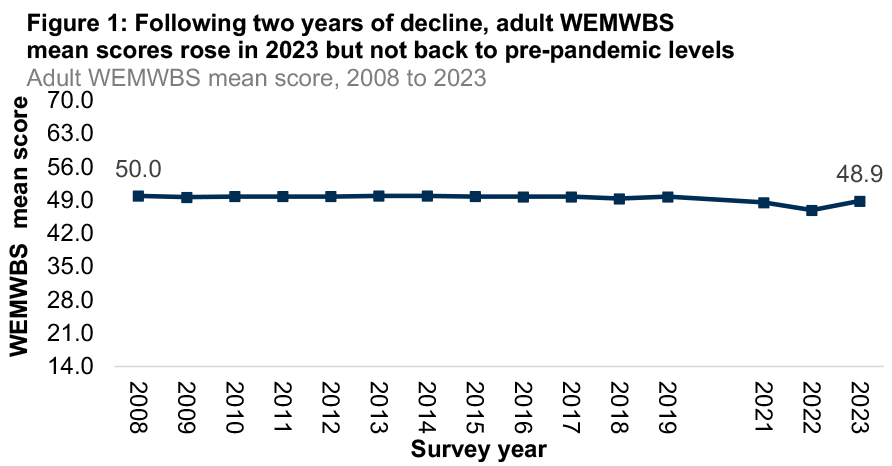
- The proportion of adults with a GHQ-12[2] score of 4 or more (21%), indicative of a possible psychiatric disorder, returned to a similar level to 2021 (22%) following an increase to 27% in 2022.
- Adults aged 16-44 were more likely to report GHQ-12 scores of 4 or more, 23%-29% compared with 11%-14% among those aged 65 and over.
- The proportion of adults with a GHQ-12 score of 4 or more was highest among those living in the most deprived areas of Scotland (25% compared to 18% for those living in the least deprived areas).
- Adults aged 25-44 are most likely to report that their job was ‘very’ or ‘extremely stressful’ (20%-24%).
- One in ten adults (10%) reported feeling lonely ‘most’ or ‘all of the time’, with adults aged 16-24 (19%) and those living in the most deprived areas (14%) the most likely to report feeling like this in the past week.
Chapter 2: General health, Cardiovascular conditions, CPR training and Caring
In 2023:
- Around three in four adults reported their general health to be ‘very good/good’ (72%), a figure at the lower end of the range recorded since 2008 (70% - 77%). The vast majority of children continued to report ‘very good/good’ general health (94%), similar to previous years (93% - 96%).
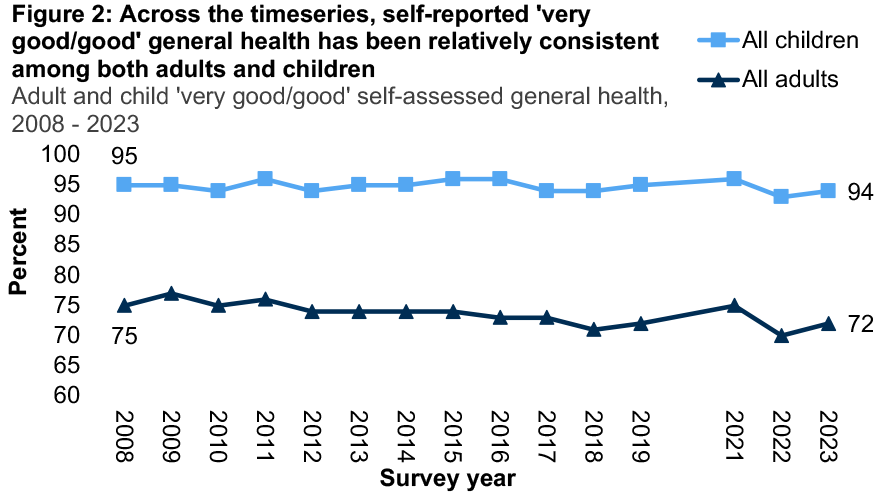
- Adult prevalence of limiting long-term conditions was 38%. Females were more likely to report living with a limiting long-term condition than males (43% and 32% respectively), with the largest difference seen for those aged 45-54 (45% and 29% respectively).
- Prevalence of any CVD (excluding diabetes or high blood pressure) remained at 15% of adults. As in previous years, prevalence increased with age from 3% among those aged 16-24 to 42% among those aged 75 and over.
- In 2022/2023 combined, around one in three adults were recorded as having hypertension[3] (31%), a similar proportion to that recorded in previous years (28%-33%).
- More than one in two adults (57%) reported having ever undertaken CPR training and one in five adults (18%) had undertaken CPR training in the last two years.
- Fourteen per cent of all adults reported being unpaid carers, a proportion which was higher among females (16%) compared with males (11%). Among unpaid carers, mental wellbeing was lower for those providing five or more hours unpaid care per week (mean WEMWBS scores of 45.1 – 47.6) compared to those providing less than five hours of care (mean of 49.2)
Chapter 3: Respiratory
In 2023:
- The proportion of adults reporting having doctor-diagnosed asthma (17%) remained in line with prevalence levels since 2017 (14-17%).
- For adults, females were more likely than males to report having doctor-diagnosed asthma (19% and 16% respectively), for children the opposite pattern was evident (12% of males and 7% of females).

- The prevalence of doctor-diagnosed asthma was higher among adults in the most deprived areas (20%) in Scotland compared with those in the least deprived areas (15%).
- Older adults were more likely than younger adults to report having doctor-diagnosed COPD (8-9% of those aged 65 and over compared to 0-1% of those aged 16-44).
- Eight per cent of adults and 2% of children reported currently having long COVID.
- Two per cent of adults reported that they had long COVID and it limited their ability to carry out day-to-day activities ‘a lot.’
Chapter 4: Dental Health
In 2023:
- The majority (94%) of adults had at least some natural teeth and this decreased with age from 99-100% of those aged 16-44 to 76% of those aged 75 and over.
- Around six in ten (62%) adults visited the dentist less than one year ago with females (66%) more likely than males (58%) to have done so.
- The proportion of adults reporting difficulties when visiting the dentist (34%) has increased since 2019 (20%) and 2021 (23%) and has returned to a similar level to 2009 (35%).
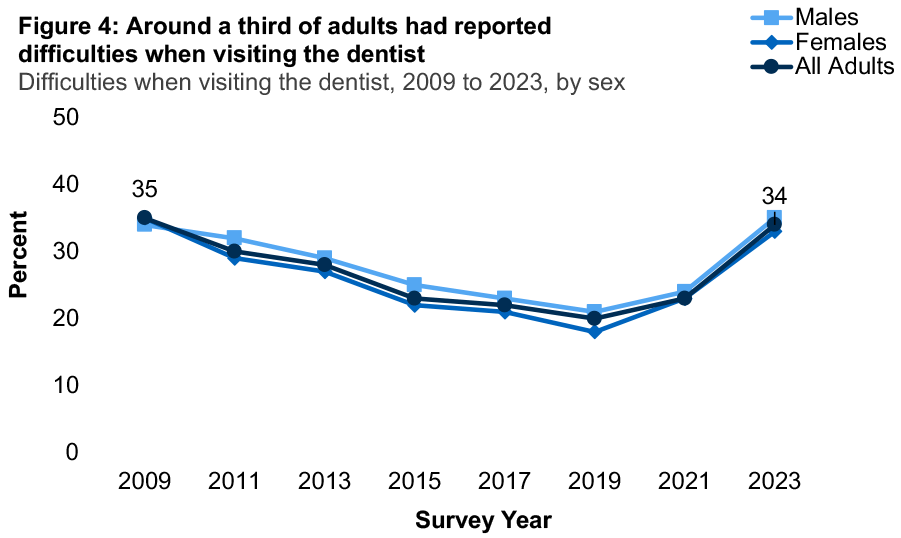
- The most common difficulties reported when visiting a dentist were: getting a suitable appointment (12%), dental treatment being too expensive (10%) and not being able to get dental treatment under the NHS (7%).
- Just under three quarters of adults who had visited a dentist in the last five years had received dental treatment only on the NHS (72%), with those aged 16-24 the most likely (82%) and those aged 25-34 the least likely to receive only NHS treatment (66%).
Chapter 5: Diet and Food Insecurity
In 2023:
- Just under a fifth (18%) of children aged 2-15 consumed five or more portions of fruit and vegetables per day, a proportion similar to 2021 (20%) and 2022 (21%) and remaining higher than in earlier years (13% in 2008).
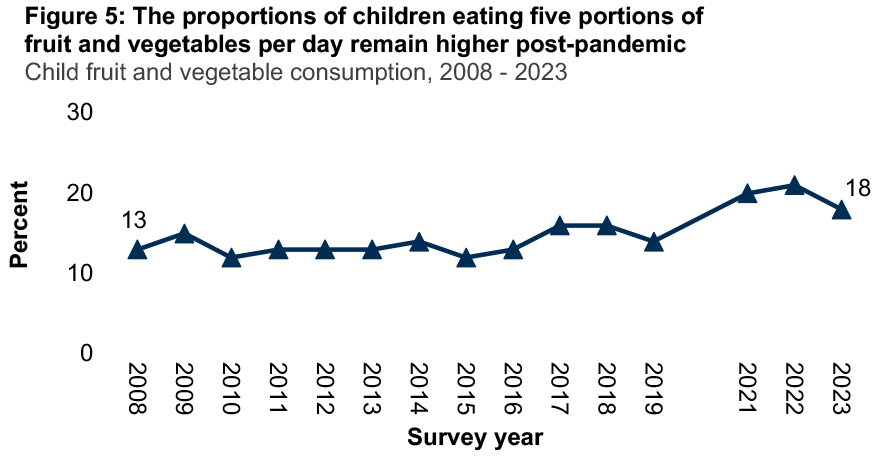
- Fruit and vegetable consumption was higher among children aged 2-7 (mean of 3.4 portions per day) compared with children aged 8-15 (mean of 2.8 portions per day).
- Fourteen per cent of adults reported experiencing food insecurity, an increase from 9% in 2021 and the highest level since the time series began in 2017.
- Almost two-thirds of adults (65%) who had worried that they would run out of food in the last 12 months reported below average life satisfaction, more than double the proportion for adults who had reported that they were not worried that they would run out of food (31%).
- A similar pattern was recorded for mental wellbeing, with much lower mean WEMWBS scores among those who had worried about running out of food (41.6 compared to 50.1 who had not). The mean WEMWBS score for those who had run out of food in the last 12 months due to a lack of money or other resources was 39.9 compared to a mean of 49.5 for those who had not.
Chapter 6: Physical Activity
In 2023:
- The proportion of adults meeting the recommended levels of physical activity[4] (63%) was not significantly lower than in 2022 (65%) and remained within the overall range recorded between 2012 and 2022 (62-69%). As in previous years, a higher proportion of men reported having met the guidelines (68%) compared with women (59%).
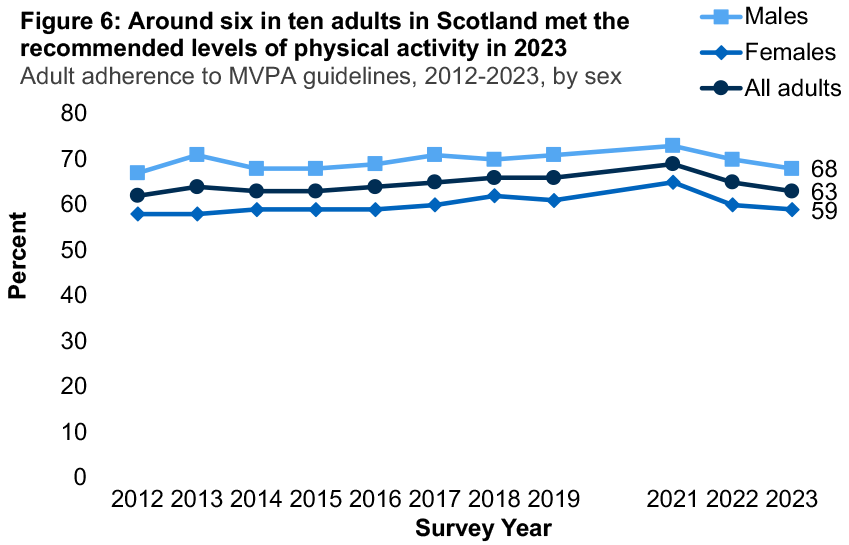
- Adults aged 75 and over were least likely to have met the physical activity guidelines (37%), although men in this age group were more likely to have done so compared with women (45% and 30% respectively).
- Only one in two adults living in Scotland’s most deprived areas met the recommended level of physical activity (50%), one of the lowest proportions in the 2012–2023 timeseries.
- Adherence to recommended physical activity levels[5] was lowest for children aged 13-15. A notably lower proportion of girls aged 13-15 met the recommended physical activity level compared with boys in this group (43% and 67% respectively).
- Adults aged 65 and over recorded the highest amount of time spent on sedentary activities.
Chapter 7: Smoking
In 2023:
- Around one in seven (15%) adults were current smokers, the same proportion as in 2022. Smoking was least prevalent among those aged 75 and over (6%).
- Smoking prevalence was highest among adults living in the most deprived areas in Scotland (26%), and lowest among those living in the least deprived areas (6%).
- Twelve per cent of all adults were current e-cigarette or vaping device users, an increase from 10% in 2022. The proportion was highest for adults aged 16-24 (22%).
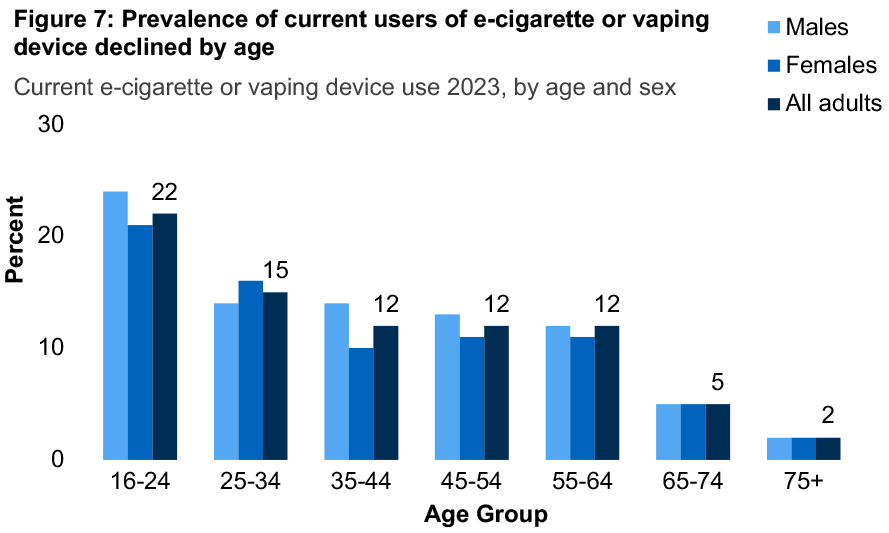
- Prevalence of current e-cigarette or vaping device use was highest among adults living in the most deprived areas of Scotland (17%), and lowest among those living in the least deprived areas (6%).
- The proportion of adults exposed to second-hand smoke in their own homes has reduced by 19 percentage points between 2003 (25%) and 2023 (6%).
- The proportion of children aged 0-15 exposed to second-hand smoke in their own homes was eight percentage points lower in 2023 (4%) than in 2012 (12%).
- Younger adults aged 16-24 were most likely to have used e-cigarettes or vaping devices in their most recent attempt to stop smoking, 44% compared with 3% of those aged 75 and over.
Chapter 8: Alcohol and Drugs
In 2023:
- The prevalence of hazardous or harmful alcohol consumption[6] continued to decrease, with levels falling from 34% in 2003 to 20% in 2023. The proportion of males that drank to hazardous or harmful levels was twice as high as that of females (28% and 14% respectively).

- With the exception of 2021 (14%), the proportion of adults with an AUDIT[7] score of eight or more (hazardous/ harmful drinking or possible alcohol dependency) has remained in the range 17%-19% (18% in 2023).
- Adults living in the most deprived areas of Scotland were more likely to record an AUDIT score of eight or more.
- Fourteen per cent of adults reported drug use during the last 12 months. Prevalence was highest for those aged 16-34 (26%-27%) decreasing to 4%-6% of those aged 65 and over.
- Adults who had used any drug in the last 12 months reported lower mental wellbeing than those who had not used drugs (mean WEBWBS scores of 46.3 and 49.4 respectively).
Chapter 9: Obesity
In 2023:
- Almost a third of adults (32%) were living with obesity[8], the highest level in the time series.
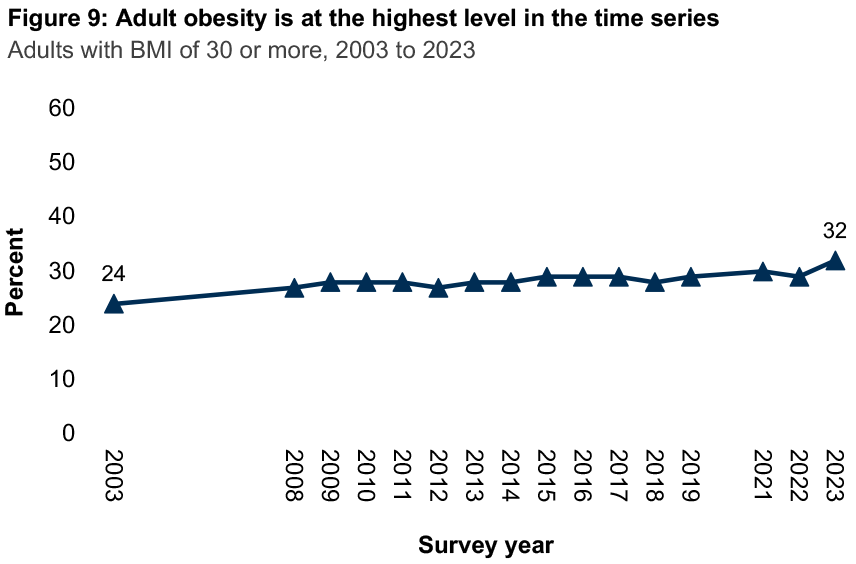
- The mean adult BMI was 28 kg/m2, the same as in 2021 and 2022, following an increase from 27.1 g/m2 in 2003.
- Adults aged 16-24 were more likely than older adults to be in the healthy weight range[9] (57%).
- Almost seven in ten children were within a healthy weight range[10] (68%) based on their BMI, this was within the range of 64%-72% recorded since 1998.
- Just under a fifth of children (17%) were at risk of obesity[11], a proportion that has remained in the range 13%-18% since 1998.
In 2022/2023 combined:
- Just under two-thirds of adults had at least an increased health risk based on their BMI and waist circumference (64%).
Notes
1 The Warick-Edinburgh Mental Wellbeing Scale (WEMWBS) measures mental wellbeing. WEMWBS scores range from 14 to 70. Higher scores indicate greater wellbeing.
2 GHQ-12 scores range from 0 to 12. Scores of 4 or more are indicative of a possible psychiatric disorder.
3 Nurse equivalent calibrated estimates.
4 At least 150 minutes of moderately intense physical activity or 75 minutes of vigorous activity per week or an equivalent combination of both.
5 An average of at least 60 minutes of activity per day in previous week.
6 Hazardous/harmful drinker: more than 14 units of alcohol per week.
7 Alcohol Use Disorders Identification Test (AUDIT); score 0-7: low-risk drinking behaviour, or abstinence, score 8-15: medium level of alcohol problems (sometimes described as hazardous drinking behaviour), score 16-19: high level of alcohol problems (harmful drinking behaviour), score 20 or above: warrants further investigation for possible alcohol dependence.
8 A BMI of at least 30 kg/m2.
9 A BMI of at least 18.5kg/m2 to less than 25 kg/m2.
10 Within healthy range = BMI above 2nd percentile, below 85th percentile.
11 At risk of obesity = BMI at or above 95th percentile.
Contact
There is a problem
Thanks for your feedback